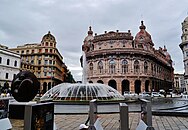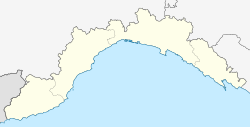
Back Genua Afrikaans Genua ALS ጄኖቫ Amharic Chenova AN جنوة Arabic چينوا ARZ Xénova AST Genova Aymara Genuya Azerbaijani جینووا AZB
Genoa
| |
|---|---|
| Comune di Genova | |
Skyline of Genoa XX Settembre street | |
|
| |
| Coordinates: 44°24′40″N 8°55′58″E / 44.41111°N 8.93278°E | |
| Country | Italy |
| Region | Liguria |
| Metropolitan city | Genoa (GE) |
| Government | |
| • Mayor | Pietro Piciocchi (acting) (FdI) |
| Area | |
• Total | 240.29 km2 (92.78 sq mi) |
| Elevation | 20 m (70 ft) |
| Population (1 January 2018)[2] | |
• Total | 580,097 |
| • Density | 2,400/km2 (6,300/sq mi) |
| Demonym(s) | Genoese, Genovese |
| Time zone | UTC+1 (CET) |
| • Summer (DST) | UTC+2 (CEST) |
| Postal code | 16121-16167 |
| Dialing code | 010 |
| ISTAT code | 010025 |
| Patron saint | John the Baptist |
| Saint day | 24 June |
| Website | comune |
| Official name | Genoa: Le Strade Nuove and the system of the Palazzi dei Rolli |
| Criteria | Cultural: (ii)(iv) |
| Reference | 1211 |
| Inscription | 2006 (30th Session) |
| Area | 15.777 ha (38.99 acres) |
| Buffer zone | 113 ha (280 acres) |
Genoa (/ˈdʒɛnoʊə/ JEN-oh-ə; Italian: Genova [ˈdʒɛːnova] ⓘ; Ligurian: Zêna [ˈzeːna])[a] is a city in and the capital of the Italian region of Liguria, and the sixth-largest city in Italy. In 2023, 558,745 people lived within the city's administrative limits.[3] While its metropolitan city has 813,626 inhabitants,[3] more than 1.5 million people live in the wider metropolitan area stretching along the Italian Riviera.[4]
On the Gulf of Genoa in the Ligurian Sea, Genoa has historically been one of the most important ports on the Mediterranean: it is currently the busiest in Italy and in the Mediterranean Sea and twelfth-busiest in the European Union.[5][6]
Genoa was the capital of one of the most powerful maritime republics for over seven centuries, from the 11th century to 1797.[7] Particularly from the 12th century to the 15th century, the city played a leading role in the history of commerce and trade in Europe, becoming one of the largest naval powers of the continent and considered among the wealthiest cities in the world.[8][9] It was also nicknamed la Superba ("the proud one") by Petrarch due to its glories on the seas and impressive landmarks.[10] The city has hosted massive shipyards and steelworks since the 19th century, and its solid financial sector dates back to the Middle Ages. The Bank of Saint George, founded in 1407, is the oldest known state deposit bank in the world and has played an important role in the city's prosperity since the middle of the 15th century.[11][12]
The historical centre, also known as old town, of Genoa is one of the largest and most-densely populated in Europe.[13] Part of it was also inscribed on the World Heritage List (UNESCO) in 2006 as Genoa: Le Strade Nuove and the system of the Palazzi dei Rolli. Genoa's historical city centre is also known for its narrow lanes and streets that the locals call "caruggi".[14] Genoa is also home to the University of Genoa, which has a history going back to the 15th century, when it was known as Genuense Athenaeum. The city's rich cultural history in art, music and cuisine allowed it to become the 2004 European Capital of Culture. It is the birthplace of Guglielmo Embriaco, Christopher Columbus, Andrea Doria, Niccolò Paganini, Giuseppe Mazzini, Renzo Piano and Grimaldo Canella, founder of the House of Grimaldi, among others.
Genoa, which forms the southern corner of the Milan-Turin-Genoa industrial triangle of Northwest Italy, is one of the country's major economic centres.[15][16] A number of leading Italian companies are based in the city, including Fincantieri, Leonardo,[17] Ansaldo Energia,[18] Ansaldo STS, Erg, Piaggio Aerospace, Mediterranean Shipping Company and Costa Cruises.
- ^ "Superficie di Comuni Province e Regioni italiane al 9 ottobre 2011". Italian National Institute of Statistics. Retrieved 16 March 2019.
- ^ "Popolazione Residente al 1° Gennaio 2018". Italian National Institute of Statistics. Retrieved 16 March 2019.
- ^ a b "Bilancio demografico mensile". demo.istat.it. Retrieved 28 April 2023.
- ^ "Urbanismi, Cluster urbani e aree metropolitane – volume primo, Italia" (PDF) (in Italian). Archived from the original (PDF) on 6 October 2014. Retrieved 23 February 2013.
- ^ "Genoa". Encyclopædia Britannica. Encyclopædia Britannica, inc. Retrieved 24 March 2017.
- ^ "Maritime ports freight and passenger statistics". Eurostat. Retrieved 24 March 2017.
- ^ "Genoa: a bloody history, a beguiling present". London: Times Online. 25 April 2004. Retrieved 11 April 2009.[dead link]
- ^ "This City Once Ruled the Mediterranean. Now It's Eyeing a Comeback". Bloomberg.com. 19 February 2019. Retrieved 15 November 2020.
- ^ "Genoa | Geography, History, Facts, & Points of Interest". Encyclopedia Britannica. Retrieved 11 December 2020.
- ^ "Genova "la Superba": l'origine del soprannome". GenovaToday (in Italian). Retrieved 11 December 2020.
- ^ Macesich, George (2000). Issues in Money and Banking. Greenwood Publishing Group. p. 42. ISBN 978-0-275-96777-2.
- ^ Alta Macadam, Northern Italy: From the Alps to Bologna, Blue Guides, 10th edn. (London: A. & C. Black, 1997).
- ^ "Centro storico di Genova, caruggi, città vecchia, vicoli, Genova di de André | Visitgenoa.it Historic centre". www.visitgenoa.it. Archived from the original on 15 August 2020. Retrieved 17 August 2020.
- ^ Belford, Ros; Dunford, Martin; Woolfrey, Celia (2003), Rough Guide to Italy, Rough Guides, p. 114, ISBN 9781843530602, retrieved 22 October 2021
- ^ 'Genoa Economy' Archived 13 June 2010 at the Wayback Machine, World66.com.
- ^ 'Italy: Industry', Encyclopedia of the Nations, Advameg, Inc.
- ^ "Selex ES: Company profile". LinkedIn Corporation. Archived from the original on 27 November 2013.
- ^ "Ansaldo Energia: Company profile". LinkedIn Corporation. Archived from the original on 12 December 2013.
Cite error: There are <ref group=lower-alpha> tags or {{efn}} templates on this page, but the references will not show without a {{reflist|group=lower-alpha}} template or {{notelist}} template (see the help page).














